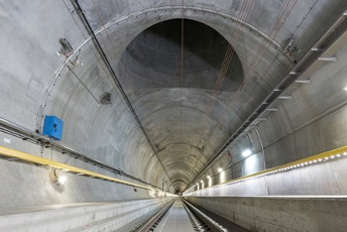Tunnels, canals and other holes in the ground play an important but often forgotten part in transport. Well no more, here are the top five holes in the ground that are well worth...looking into.
1) Light at the end of the tunnel
This month the world’s longest and deepest rail tunnel officially opened in Switzerland, which also has holes in its cheese. The 35-mile twin-bore Gotthard base tunnel for high speed rail cost £8.3bn to build, took 17 years, and dives 2.3 km beneath the Swiss Alps.

The 35-mile twin-bore Gotthard base tunnel
The nation’s leaders hope it will revolutionise north to south European trade and take a million lorries a year off the roads. Let’s hope it works. Tragically nine tunnel miners died building the tunnel.
2) The canal named after a hat
The Panama Canal is a man-made 48-mile waterway connects the Atlantic and Pacific Oceans. It was constructed by the United States between 1904 and 1913 at a cost of $375m at the time, and was opened in 1914. The cutting revolutionised global sea traffic by providing a short cut for vessels that would otherwise have to go around the bumpy bit at Cape Horn.
The Panama Canal Expansion will create a new lane of traffic along the canal through the construction of a new set of locks, doubling the waterway’s capacity. Work on the expansion project began in 2007, has cost of $5.2bn, and is on the verge of completion.
3) Going underground
The London Underground includes the world's first underground railway, the Metropolitan Railway, which opened in 1863. The Tube network now consists of 11 lines and carries over a billion passengers a year. Despite its name, the majority of the Underground is actually not in underground tunnels.
More recently, Crossrail (1) has been hailed as an engineering triumph, to the point where ministers felt it safe enough to name it the Elizabeth Line. It was such a good idea they want to build another one. Let’s call it Crossrail 2 until they decide to call it Elizabeth II.
4) The gorge that sparked a revolution
The Ironbridge Gorge, previously the Severn Gorge, in Shropshire, played a key role in Britian’s industrial revolution, not least because of further holes in the ground. Coal, iron ore, limestone and clay, the raw materials for the manufacture of iron, tiles and porcelain, are exposed or easily mined in the gorge.
Coalbrokedale in the gorge was where Abraham Darby first smelted iron ore, using easily mined local coking coal. The Iron Bridge itself opened in 1781 and was the first arch bridge in the world to be made of cast iron.
5) Mind your head!
The infamous Traitors Gate, is the water-gate entrance to the Tower of London. It was designed by medieval architect Master James of St George on the orders of King Edward I between 1275 and 1279 to provide a new water-gate by which the king could arrive at the Tower by river. But…
As the Tower of London increasingly came to be used as a prison for those accused of treason, the gate acquired its current name from the number of prisoners who passed through it. In Tudor times, famous prisoners such as Anne Boleyn and her daughter Princess Elizabeth - the future Elizabeth I – passed through the gate. But they held the name Elizabeth back for future use.
Register now for full access
Register just once to get unrestricted, real-time coverage of the issues and challenges facing UK transport and highways engineers.
Full website content includes the latest news, exclusive commentary from leading industry figures and detailed topical analysis of the highways, transportation, environment and place-shaping sectors.
Use the link below to register your details for full, free access.
Already a registered? Login